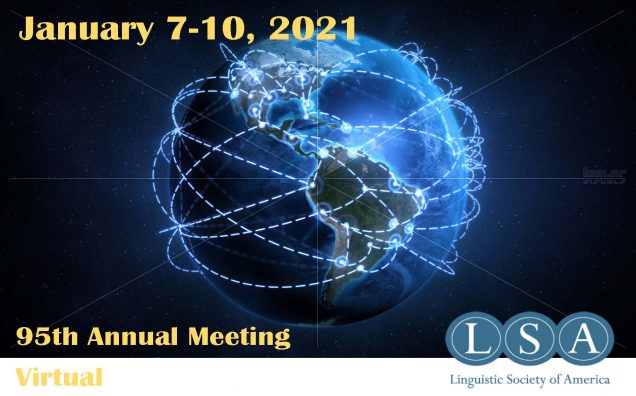Recent news
Chang at Western U.
Next Wednesday (March 31), Prof. Chang will be giving a talk in the L2 Speech Learning Group at Western University about joint work with Prof. Yao Yao (Hong Kong Polytechnic University). The title of the talk is "An individual-differences perspective on variation in heritage Mandarin speakers".

Chang at GULP
This Thursday (January 28), Prof. Chang will be giving a talk in the Glasgow University Laboratory of Phonetics (GULP). The title of the talk is "Development of speech perception and production in multilingualism".

Chang at UBC
This Friday (January 15), Prof. Chang will be giving a virtual colloquium in the Department of Linguistics at the University of British Columbia (UBC). The title of the colloquium is "Phonological learning in multilingual contexts".

PAMLab at LSA 2021
The lab will be represented at this weekend's virtual Linguistic Society of America Meeting by PhD student Felix Kpogo, who will be presenting the poster "Developmental variation in production of complex-simplex stop contrasts in Ga" (coauthored with Prof. Chang) in the Friday afternoon Language Acquisition poster session (2pm PST / 5pm EST, Poster Room 2).

Chang at Southampton
This Wednesday (November 25), Prof. Chang will be giving a virtual colloquium at the University of Southampton in the Centre for Linguistics, Language Education and Acquisition Research (CLLEAR). The title of the colloquium is "Continuity of native language development in adulthood: The case of phonetic drift".

Chang at NUPFFALE
Next week, Prof. Chang will be the keynote speaker at the upcoming (November 23) online meeting of NUPFFALE (Núcleo de Pesquisa em Fonética e Fonologia Aplicada à Língua Estrangeira) at Federal University of Santa Catarina (UFSC).

Paper in Languages (Chang & Kwon)
A paper entitled "The contributions of crosslinguistic influence and individual differences to nonnative speech perception" (Chang & Kwon, 2020) has been published in the "Exploring Cross-linguistic Effects and Phonetic Interactions in the Context of Bilingualism" special issue of Languages, guest-edited by Dr. Mark Amengual.
Abstract: Perception of a nonnative language (L2) is known to be affected by crosslinguistic transfer from a listener’s native language (L1), but the relative importance of L1 transfer vis-a-vis individual learner differences remains unclear. This study explored the hypothesis that the nature of L1 transfer changes as learners gain experience with the L2, such that individual differences are more influential at earlier stages of learning and L1 transfer is more influential at later stages of learning. To test this hypothesis, novice L2 learners of Korean from diverse L1 backgrounds were examined in a pretest-posttest design with respect to their perceptual acquisition of novel L2 consonant contrasts (the three-way Korean laryngeal contrast among lenis, fortis, and aspirated plosives) and vowel contrasts (/o/-/ʌ/, /u/-/ɨ/). Whereas pretest performance showed little evidence of L1 effects, posttest performance showed significant L1 transfer. Furthermore, pretest performance did not predict posttest performance. These findings support the view that L1 knowledge influences L2 perception dynamically, according to the amount of L2 knowledge available to learners at that time. That is, both individual differences and L1 knowledge play a role in L2 perception, but to different degrees over the course of L2 development.
This study followed Open Science practices, and all materials and data are publicly accessible via the Open Science Framework at https://osf.io/um7r4/.
Chang at Poliglotar 2020
This weekend, Prof. Chang will be one of the invited speakers at Poliglotar 2020 (Conferência Poliglota do Brasil). The title of his presentation is "Language attrition and relearning in adulthood".

Welcome to this fall’s labbies!
Welcome to the seven students who will be joining the lab this semester (virtually):
- Allie Asaro (SAR '20) is a senior majoring in Speech, Language, and Hearing Sciences. An aspiring speech-language pathologist, she is interested in bilingual language acquisition and implications for the field of speech-language pathology, especially for distinguishing between language difference and disorder.
- Jack Brown (CAS '22) is a junior double-majoring in Spanish and Latin American Studies and minoring in Portuguese and Brazilian Cultural Studies. His interests are in language contact, language acquisition in immigrant contexts, Romance linguistics, and the linguistics of indigenous Andean languages.
- Danielle Dionne (GRS '23) is a third-year PhD student in Linguistics. She is working in the lab as a research fellow for the 2020-21 academic year. Her interests include phonetics, bilingualism, cross-linguistic pragmatics, and computational linguistics.
- Yuhao He (CAS '21) is a senior majoring in Computer Science and minoring in Linguistics. His interests are in computational linguistics, natural language processing, and phonetics.
- Jackson Kellogg (GRS '25) is a first-year PhD student in Linguistics. His interests are in phonetics, language acquisition, and typology, with a particular interest in phonetic drift and language rhythm. He completed his master's degree at Arizona State University with a thesis entitled "A Rhythmic Analysis of Scottish Gaelic Using Durational Metrics".
- Maya Sanchez is a senior majoring in Linguistics at Barnard College of Columbia University. Her interests are in multilingualism and phonetics. Her senior thesis is focusing on bilingual English and Spanish speakers and their use (or non-use) of "Spanglish" in their everyday lives.
- Yash Subrahmanyam (CAS '23) is a sophomore majoring in Computer Science and minoring in Linguistics. His interests are in language acquisition, multilingualism, sociolinguistics, and computational linguistics.
And a warm welcome back to Michael, Felix, Kevin, and Shane!
Kpogo in International Journal of Bilingualism
Congratulations to third-year PhD student Felix Kpogo on the publication of his article "The influence of native English-speaking environment on Akan-English bilinguals' production of English inter-dental fricatives" (with Virginia Gathercole) in the August 2020 issue of the International Journal of Bilingualism!
- Felix Kpogo & Virginia C. Mueller Gathercole: "The influence of native English-speaking environment on Akan-English bilinguals' production of English inter-dental fricatives"
Aims and Objectives: This study examined how age of acquisition, immersion in a native English-speaking environment, and phonological environment influence Akan-English bilinguals’ production of English inter-dental fricatives.
Design/Methodology: Forty-five Akan-English bilinguals who immigrated to the USA between the ages of 10 and 64 participated. English inter-dental fricatives occurring in word-initial, intervocalic, and word-final positions were elicited through a production task using sentence frames. Accuracy of production was analyzed relative to age of acquisition, relative length of immersion, and phonological environment.
Findings/Conclusion: Performance was better overall on the voiceless than the voiced inter-dental, but the phonological environment mattered: performance was at ceiling for both in the medial position, but less good in the initial and final positions. Early age of acquisition conspired with length of residence in the USA to foster better production for both sounds. However, substitutions for target segments were still observed in the most fluent speakers. These results indicate that in determining speakers’ proficiency in the second language, we must consider all of these factors—phonological environment, age of acquisition, and length of stay—together to gain a comprehensive picture of development.
Originality: Few studies have examined Ghanaian speakers’ English, even though English is the official language of Ghana. Further, previous studies on second-language speakers’ abilities with inter-dental fricatives have largely focused on word-initial environments. The present study reveals that distinct phonological environments may not show the same effect. Here, speakers were particularly accurate in intervocalic positions.
Significance: This study contributes to theoretical debates concerning the roles of input and age of acquisition for second-language learning. It also provides insights on some of the possible hurdles that second-language learners face as they strive to acquire additional languages, which can assist second-language teachers in designing appropriate methodologies to help learners.